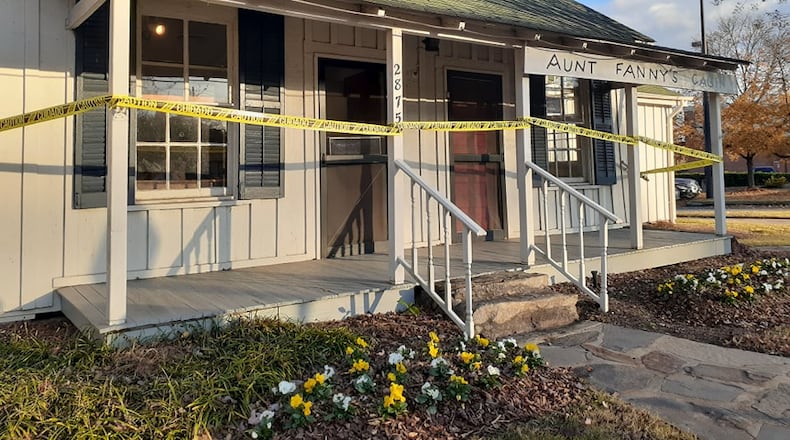Once, it was one of the most popular restaurants south of the Mason-Dixon. Now it languishes on the edge of downtown Smyrna almost forgotten, a subtle reminder of a more racist past.
Aunt Fanny’s Cabin attracted diners for decades. People traveled to Smyrna from around the world for the restaurant’s famous southern cooking. But Aunt Fanny’s Cabin gained infamy for using derogatory depictions of Black people to entertain dinner guests.
Hundreds of autographed photos signed by celebrity guests lined the walls near the front door.
From sports icons Jack Dempsey and Ty Cobb to Hollywood luminaries like Doris Day and famed Atlanta entertainer Nipsey Russell, the guest list at Aunt Fanny’s Cabin was star-studded. It was such a favorite of former President Jimmy Carter that he made the cabin a tour stop on his presidential campaigns.
Aunt Fanny’s Cabin was an expansive restaurant along Campbell Road that seated up to 200 patrons in its heyday. Now it’s a scaled-down, condemned husk of the landmark it once was.
A city task force has been assembled that could restore some of its former luster, but not everyone wants to use public funds to immortalize the restaurant that thrived, in part, by making demeaning racial stereotypes profitable.
Historians say Aunt Fanny’s Cabin spawned a generation of restaurants that capitalized off the “Old South” decor and theme. Some even mimicked the racially tinged tropes the cabin popularized.
Credit: LANE BROS. COMMERCIAL PHOTOGRAPHS / GSU
Credit: LANE BROS. COMMERCIAL PHOTOGRAPHS / GSU
The city’s task force must now struggle to reconcile the cabin’s ugly past with its historical value to Smyrna.
Smyrna is at a crossroad many cities across the globe have come to grips with over the past 18 months. George Floyd’s death at the hands of police officers last summer triggered international unrest. Hundreds of memorials dedicated to controversial icons of the past have been removed since. Kennesaw removed the Confederate battle flag, long regarded by detractors as a racially charged symbol of hate, from the city’s war memorial in June 2020.
Smyrna’s racially-mixed task force of three city councilmembers, two residents and a local historian will decide by the end of the month whether the city should preserve, rebuild, demolish or try to give away Aunt Fanny’s Cabin.
The building is currently in shambles. It could cost close to $550,000 to revamp it and turn it into a historic monument. The price tag to tear the old cabin down and build a new version is close to $400,000, according to city estimates.
But the decision is not a strictly financial one. Task force members are confronted with a side of Aunt Fanny’s Cabin’s legacy that many today find racially insensitive.
Beyond the Smithfield hams, fried chicken and macaroni squash, there was something distasteful at the popular eatery. When owners first turned the two-room cabin into a restaurant, they designed it as a depiction of the Antebellum South.
According to critics, it became a nostalgic toast to Jim Crow-era racism served alongside Southern staples. Black boys hired as servers wore wooden menu boards around their necks and welcomed the predominantly white customers by caroling the menu to them, the Washington Post reported in 1992. They danced on table tops, gleefully proclaimed that the “South will rise again,” and pitched in when patrons sang anthems of the Antebellum South like “Dixie.”
The New York Times in 1976 reported that the walls were strewn with framed advertisements for slaves.
“I don't think (Aunt Fanny's Cabin) is what we really want to portray as Smyrna, because I don't believe it is Smyrna today."
“I don’t think that is what we really want to portray as Smyrna, because I don’t believe it is Smyrna today,” said Councilman Travis Lindley, the task force’s chairman, who is against preserving the building. “There’s certainly a lot of painful history here, but I think it’s time to start looking forward.”
Even the restaurant’s moniker is considered controversial by today’s standards. It’s named after Fanny Williams, a longtime servant of the wealthy Campbell family that was among Smyrna’s first settlers.
Family heiress Isoline Campbell originally opened Aunt Fanny’s Cabin as an antique mart and tea shop just days before Japan’s Dec. 7, 1941, attack on Pearl Harbor. She showcased Williams’ vegetable soups, goulash and gingerbread. They quickly became a more popular draw than the antiques, and Isoline Campbell shifted her business’ focus to southern cooking.
Fanny Williams was a beloved figure in the metro Atlanta community, according to Smyrna historian Mike Terry. She was a pioneering civil rights activist who spoke out passionately against Cobb County’s Ku Klux Klan and helped raise money to build the state’s first all-Black hospital in Marietta.
But critics say Aunt Fanny’s Cabin reduced Williams to the subservient symbol of a “mammy” who sat on the front porch of the restaurant in a faded calico dress and headwrap regaling customers with stories of her days as a slave.
It was a false narrative used as a marketing tactic. Williams was never a slave, according to historical records, which indicate she was born three years after President Abraham Lincoln signed the Emancipation Proclamation.
Despite helping make Aunt Fanny’s Cabin famous, Williams did not appear to have any financial stake in the restaurant, according to Terry.
“She was a mascot. She was absolutely the mascot for an Old South restaurant located here in Smyrna,” Councilman Lewis Wheaton told an AJC reporter during a recent tour of the cabin.
Credit: Matt Bruce
Credit: Matt Bruce
A fixer-upper
Pieces of Aunt Fanny’s Cabin were auctioned off soon after the restaurant closed its doors in 1992.
In 1997, after most of the structure was stripped away or torn down, the city bought the front porch and a room near the entranceway. Those salvaged pieces of the property were relocated and added to a replica of Aunt Fanny’s Cabin that was built at the city’s welcome center along Atlanta Road.
That’s where it stands now, at a railroad depot next door to the Smyrna History Museum.
The cabin celebrated its 70th anniversary this month. City officials worry it could fall apart if they don’t make a decision by Dec. 31. Cracking ceiling joints means the roof could cave in at any time. There’s no foundation beneath the building, and it’s infested with mold, asbestos and lead paint.
Anthony Carter, Smyrna’s chief building inspector, condemned Aunt Fanny’s Cabin in April after he inspected all of the city’s facilities. Carter discovered significant structural issues and declared the building unsafe and uninhabitable. The site, which was used for small events, has remained shut down since.
Mayor Derek Norton commissioned the task force in August to consider what to do with the public facility. Artisans of Atlanta Renovations, a Marietta contractor, inspected the building and estimated it will cost the city between $480,000 and $520,000 to restore; or as much as $390,000 to tear the cabin down and rebuild.
There are redeeming qualities to consider. The cabin was built as “saddlebag” house, a 19th-century style of architecture that was popular throughout Georgia during World War II. Saddlebag homes are a rarity nowadays and some Smyrna leaders want to preserve the cabin for its historical and architectural value.
“There’s certainly not another one in Smyrna. There’s (likely) not another one in Cobb County,” Councilman Charles “Corkey” Welch said. “I don’t care what the name of the cabin is. Take the name Aunt Fanny’s Cabin off of it and restore the cabin.”
Reckoning with a troubled past
Stepping into the remains of Aunt Fanny’s Cabin today is like entering a portal to a bygone era. Cast iron skillets hang on the walls above a dusty fireplace, evoking the feel of a homespun travel lodge. The floor panels grouse beneath your feet, signaling the cabin’s feebleness with each step.
Some of the relics hidden in the cabin are blunt reminders of a shameful period in American history when slaves were bought and sold as personal chattel. Lindley said he was shaken when he stumbled across a placemat stashed in one of the office drawers. It was a drawing of children in blackface gleefully advertising Aunt Fanny’s Cabin’s hot biscuits, char-broiled steaks and other favorites.
“Why would we want to memorialize that, spend money on it, and stick a city of Smyrna sign on it like, ‘This is our history, and we’re proud of it,’” the councilman said during a Nov. 18 gathering of task force members. “There is nothing to be proud of.”
Credit: Matt Bruce
Credit: Matt Bruce
Lindley represents Ward 3, the downtown Smyrna district where the cabin currently sits. He said the discussion needs to center on how to honor the legacy of Fanny Williams more so than that of Aunt Fanny’s Cabin. He was enraged to learn that Williams was buried in an unmarked pauper’s grave in Jonesboro when she died in 1949 at the age of 81.
“The problem for me is the restaurant sought fame and fortune off a romanticized view of the South,” Lindley said. “I have a problem with that and I don’t care that it’s historical.”
But Aunt Fanny’s Cabin introduced droves of people to Smyrna and helped put the Atlanta suburb on the map. Actors like Mickey Rooney, Jackie Gleason, James Cagney, Clarke Gable, Andy Griffith and John Wayne visited. It was not uncommon for political leaders from Georgia and beyond to walk through the doors.
Terry, who researched the cabin’s history for the Smyrna Historical Society, condemned the use of “menu boys” and said it was one of a number of marketing blunders the restaurant’s owners used after Campbell sold the business in 1954. But the demeaning tactics didn’t work and ceased within a few years, he said. Terry argued that the cabin should be preserved because it is still part of the city’s cultural heritage, despite the offensive narratives it painted of African Americans.
“It’s a complex culture that we live in,” Terry said. “We all know the history of the cabin. But to honor the cabin and the people that were affiliated with it is the right thing to do.”
He went on to insist that Williams deserves to be celebrated no matter what.
“She was an icon, she really was,” Terry said. “Whether we save the building or not, she’s got to be honored. She’s got to be mentioned, she’s got to have a plaque, she’s got to have a picture.”
The task force plans to meet one last time at 4 p.m. Monday at City Hall. Members will discuss the budget options for renovation and demolition. They will still be left to answer the burning question.
“Exactly what are we preserving? That is still a conundrum for me,” Wheaton asked. “We still have not nailed that. And the fact that we haven’t nailed that, for me, is indicative of the problem.”
About the Author
Keep Reading
The Latest
Featured






